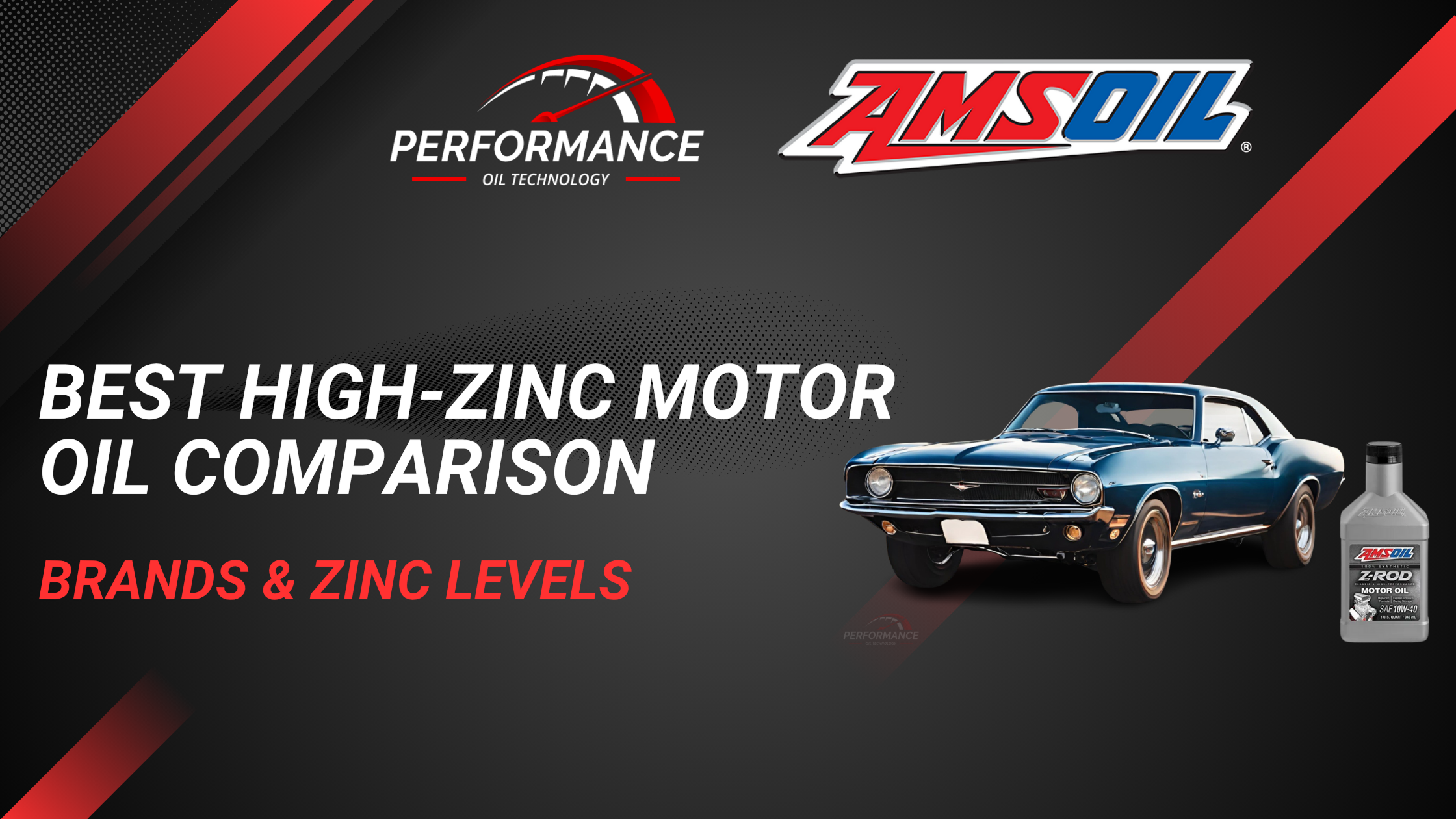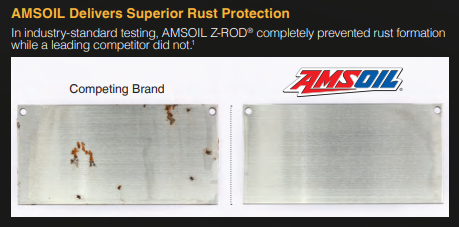Best High Zinc Motor Oil: Brands, Zinc Content & More

Top Insights
If you own a classic car or hot rod with a flat-tappet camshaft, choosing the right motor oil can mean the difference between decades of reliable performance and catastrophic engine failure. Since 2004, when the API reduced zinc levels to protect catalytic converters, classic car owners have faced a critical challenge: modern oils don't provide adequate protection for vintage flat-tappet engines.
This guide compares the best high-zinc motor oils available today. As a former Ford truck/automotive engineer and seasoned AMSOIL dealer, I've tested and used many of these products extensively across various engine types and applications.
Motor Oil Zinc Content Chart
Here's the definitive zinc content comparison showing actual ZDDP levels across the top high-zinc motor oils:
*Royal Purple doesn't specify their zinc or phosphorus ppm levels, these are from real-world testing.
But can high-zinc motor oils truly be compared with another by just strictly looking at zinc & phosphorus levels? We certainly don't think this is the case. Any engine oil is only as effective as it's entire formulation. Below we'll look at how these oils truly stack up against one another.
Top 5 High Zinc Motor Oils Compared
1. AMSOIL Z-ROD (Best Overall)
AMSOIL Z-ROD touts the highest flash point (254°C) and the lowest NOACK volatility of the products that provide those specifications, suggesting very good high-temperature stability and low oil consumption. Unlike racing-specific oils requiring frequent changes, Z-ROD supports 5,000-mile service intervals. With their Preferred Customer pricing, you can pickup a quart of AMSOIL Z-ROD 20W-50 for a fraction of the cost of Royal Purple HPS (the most expensive product in our comparison).
Z-ROD is also highly protective during long-term storage. Z-ROD was tested in ASTM D1748-10 (Rust Protection by Metal Preservatives in the Humidity Cabinet) to evaluate rust-preventative properties of oil under high-humidity conditions, similar to those faced by a covered hot rod in a damp garage. The metal coupon treated with AMSOIL Z-Rod showed no signs of rust.

For it's effectiveness and overall value, AMSOIL Z-ROD is the best overall high-zinc motor oil in our opinion and is a great choice for daily-driven classics, performance street cars and hot rods that experience extended storage periods.
2. Royal Purple HPS (Best Premium Full Synthetic)
Royal Purple's HPS 20W-50 boasts some impressive specifications, but for it's premium price point (over $18 per quart), it better! With the highest viscosity index, TBN, and lowest Cold Crank Simulator spec and pour point of all the oils we've compared, Royal Purple HPS shines through as having the best viscosity stability across temperature ranges, longer-lasting acid-neutralizing capabilities and superior cold-weather protection.
If you want to pay the most for the most premium quality full synthetic high-zinc motor oil, Royal Purple HPS is your best bet.
3. Valvoline VR1 (Best Budget Option)
Valvoline VR1 conventional just barely nudges out Castrol GTX Classic as one of the best conventional high zinc motor oils, with a decent viscosity index of 127 and a TBN of 8.3 which is nearly on par with the full synthetics in our comparison. VR1 is one of the cheapest high-zinc motor oil products we've compared. For these reasons, Valvoline VR1 is the best budget option for those wanting high-zinc oil protection at the lowest cost.
4. Castrol GTX Classic
Castrol reintroduced their authentic 1980s API SJ formulation specifically for classic cars. Contains 1,400 ppm zinc—adequate for flat-tappet protection under normal service. Available at Walmart and select auto parts stores. Standard 3,000-5,000 mile intervals.
5. Lucas Hot Rod & Classic
Contains the highest zinc content available in a conventional street oil. Standout feature: marine-grade corrosion protection for vehicles stored seasonally or driven infrequently. Race fuel compatible. While ultra-high zinc provides maximum cam protection, it's higher than necessary for most applications.
Important Warnings
- High-zinc oils WILL damage catalytic converters. Only use in pre-emissions vehicles or where catalytic converters have been removed.
- Break-in oils must be changed after 500-1,000 miles. Ultra-high zinc causes bearing damage if used long-term.
- Racing oils require frequent changes. Designed for competition use, not extended street intervals.
- Modern roller cam engines don't need high zinc. Using high-zinc oils provides no benefit and harms emissions equipment.
How Much Zinc Does Your Engine Need?
1,200-1,600 ppm (Street Flat-Tappet Engines)
This range protects flat-tappet camshafts under normal street driving. All the street oils in our comparison fall within this proven range. This is what you need for classic cars, hot rods, and vintage V8s.
1,800-2,400 ppm (Break-In & Racing Only)
Ultra-high zinc for initial engine break-in or racing applications. Must be changed within 500-1,000 miles. Prolonged use causes bearing damage.
Under 1,000 ppm (Modern Roller Cams)
Current API SP specification oils. Adequate for roller lifter engines but insufficient for flat-tappet protection. Don't use these in classic engines.
Warning: Engines with catalytic converters should NOT use high-zinc oils, as phosphorus will gradually poison the catalyst. Most flat-tappet engines predate catalytic converters, making this less of a concern for classic cars.
Why Diesel Oils No Longer Work for Classic Cars
The Forum Advice is Outdated
If you've spent time on classic car forums, you've likely seen recommendations to "just run Rotella T6" or another diesel oil in your flat-tappet engine. This advice is dangerously outdated.
What Changed?
Pre-2007 (API CI-4+ specification):
- Shell Rotella, Chevron Delo, Mobil Delvac contained 1,200-1,400 ppm zinc
- Adequate protection for flat-tappet camshafts
- Forum recommendations were valid
2007 (API CJ-4 specification):
- EPA emissions standards forced reformulation
- Zinc reduced to ~1,000-1,100 ppm
- Marginal for flat-tappet protection
2017-Present (API CK-4 specification):
- Further reduced to 800-900 ppm zinc
- Insufficient for flat-tappet protection
- Formulated for diesel particulate filter (DPF) compatibility, not classic engines
How to Identify Old Stock
If you find old bottles of diesel oil, check the API service donut on the back label:
- CI-4 or CI-4+: May contain adequate zinc (1,200+ ppm) — verify manufacture date
- CJ-4: Marginal zinc levels (1,000-1,100 ppm)
- CK-4 or FA-4: Modern formulation — inadequate for flat-tappet engines
Most diesel oil on shelves today is CK-4 specification. The bottles that worked for classic cars 15-20 years ago simply don't exist in current formulations.
Final Recommendations
For most street-driven classics with flat-tappet cams, AMSOIL Z-ROD offers the best overall value. The fully synthetic base provides superior temperature stability, 5,000-mile service intervals reduce maintenance frequency, and adequate zinc levels protect without excessive bearing wear risks.
Budget-conscious owners get excellent protection from Valvoline VR1 conventional at accessible prices. Modified engines benefit from Royal Purple HPS with LSPI protection.
The key is matching oil characteristics to your specific application: engine design, driving patterns, storage conditions, and maintenance intervals all factor into the optimal choice.
Ready to protect your classic? Shop AMSOIL Z-ROD oils and take advantage of Preferred Customer pricing for up to 25% savings.
Get FREE Shipping!
Save up to 25% on all AMSOIL products and get FREE shipping on orders of at least $100. Learn more below.
Related Articles
SAVE 25% + FREE Shipping!
Sign up today for 25% off all AMSOIL products and get FREE shipping on orders of $100 or more as a Preferred Customer.




